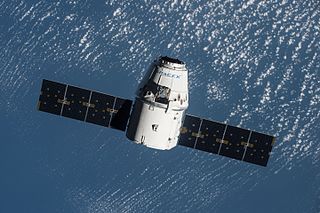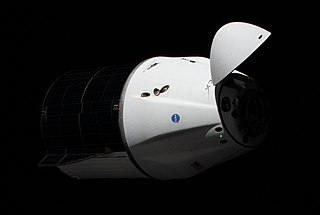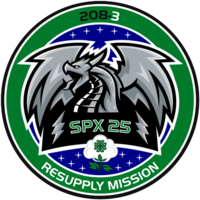
Cygnus is an expendable American cargo spacecraft developed by Orbital Sciences Corporation but manufactured and launched by Northrop Grumman Space Systems as part of NASA's Commercial Resupply Services (CRS) program. It is usually launched by Northrop Grumman's Antares rocket from the Wallops Flight Facility, although three flights were on ULA's Atlas V and three are planned for SpaceX's Falcon 9, in both cases launching from Cape Canaveral Space Force Station. It transports supplies to the International Space Station (ISS) following the retirement of the American Space Shuttle. Since August 2000, ISS resupply missions have been regularly flown by the Russian Progress spacecraft, as well as by the European Automated Transfer Vehicle, and the Japanese H-II Transfer Vehicle. With the Cygnus spacecraft and the SpaceX Dragon, NASA seeks to increase its partnerships with domestic commercial aviation and aeronautics industry.

SpaceX CRS-3, also known as SpX-3, was a Commercial Resupply Service mission to the International Space Station (ISS), contracted to NASA, which was launched on 18 April 2014. It was the fifth flight for SpaceX's uncrewed Dragon cargo spacecraft and the third SpaceX operational mission contracted to NASA under a Commercial Resupply Services (CRS-1) contract.

SpaceX CRS-4, also known as SpX-4, was a Commercial Resupply Service mission to the International Space Station (ISS), contracted to NASA, which was launched on 21 September 2014 and arrived at the space station on 23 September 2014. It was the sixth flight for SpaceX's uncrewed Dragon cargo spacecraft, and the fourth SpaceX operational mission contracted to NASA under a Commercial Resupply Services contract. The mission brought equipment and supplies to the space station, including the first 3D printer to be tested in space, a device to measure wind speed on Earth, and small satellites to be launched from the station. It also brought 20 mice for long-term research aboard the ISS.

SpaceX CRS-6, also known as SpX-6, was a Commercial Resupply Service mission to the International Space Station, contracted to NASA. It was the eighth flight for SpaceX's uncrewed Dragon cargo spacecraft and the sixth SpaceX operational mission contracted to NASA under a Commercial Resupply Services contract. It was docked to the International Space Station from 17 April to 21 May 2015.

SpaceX CRS-9, also known as SpX-9, is a Commercial Resupply Service mission to the International Space Station which launched on 18 July 2016. The mission was contracted by NASA and is operated by SpaceX using a Dragon capsule.

SpaceX CRS-11, also known as SpX-11, was a Commercial Resupply Service mission to the International Space Station, launched successfully on 3 June 2017. The mission was contracted by NASA and was flown by SpaceX. The mission utilized a Falcon 9 launch vehicle and was the first reuse of C106, a CRS Dragon cargo vessel that was previously flown on the CRS-4 mission.

SpaceX CRS-13, also known as SpX-13, was a Commercial Resupply Service mission to the International Space Station launched on 15 December 2017. The mission was contracted by NASA and is flown by SpaceX. It was the second mission to successfully reuse a Dragon capsule, previously flown on CRS-6. The first stage of the Falcon 9 Full Thrust rocket was the previously flown, "flight-proven" core from CRS-11. The first stage returned to land at Cape Canaveral's Landing Zone 1 after separation of the first and second stage.

SpaceX CRS-15, also known as SpX-15, was a Commercial Resupply Service mission to the International Space Station launched 29 June 2018 aboard a Falcon 9 rocket. The mission was contracted by NASA and flown by SpaceX.

SpaceX CRS-16, also known as SpX-16, was a Commercial Resupply Service mission to the International Space Station launched on 5 December 2018 aboard a Falcon 9 launch vehicle. The mission was contracted by NASA and is flown by SpaceX.

SpaceX CRS-19, also known as SpX-19, was a Commercial Resupply Service mission to the International Space Station. The mission is contracted by NASA and was flown by SpaceX on a Falcon 9 rocket.

SpaceX CRS-21, also known as SpX-21, was a Commercial Resupply Service mission to the International Space Station which launched on 6 December 2020. The mission was contracted by NASA and was flown by SpaceX using a Cargo Dragon 2. This was the first flight for SpaceX under NASA's CRS Phase 2 contract awarded in January 2016. This was also the first Cargo Dragon of the new Dragon 2 variant, as well as the first Cargo Dragon flight that was docked at the same time as a Crew Dragon spacecraft. This mission used Booster B1058.4, becoming the first NASA mission to reuse a booster previously used on a non-NASA mission. This was also first time SpaceX launched a NASA payload on a booster with more than one previous flight.

SpaceX CRS-22, also known as SpX-22, was a Commercial Resupply Services (CRS) mission to the International Space Station (ISS) that launched at 17:29:15 UTC on 3 June 2021. The mission is contracted by NASA and is flown by SpaceX using a Cargo Dragon 2. This is the second flight for SpaceX under NASA's CRS Phase 2 contract awarded in January 2016.

NG-15, previously known as OA-15, was the fifteenth launch of the Northrop Grumman robotic resupply spacecraft Cygnus and its fourteenth flight to the International Space Station (ISS) under the Commercial Resupply Services (CRS) contract with NASA. The mission launched on 20 February 2021 at 17:36:50 UTC. This is the fourth launch of Cygnus under the CRS-2 contract.

SpaceX CRS-23, also known as SpX-23, was a Commercial Resupply Service mission to the International Space Station, successfully launched on 29 August 2021 and docking the following day. The mission was contracted by NASA and was flown by SpaceX using the Cargo Dragon C208. This was the third flight for SpaceX under NASA's CRS Phase 2 contract awarded in January 2016. It was the second mission for this reusable capsule.

SpaceX CRS-24, also known as SpX-24, was a Commercial Resupply Service mission to the International Space Station launched on 21 December 2021, at 10:07:08 UTC. The mission is contracted by NASA and is flown by SpaceX using a Cargo Dragon. This is the fourth flight for SpaceX under NASA's CRS Phase 2 contract awarded in January 2016.

SpaceX CRS-26, also known as SpX-26, was a Commercial Resupply Service mission to the International Space Station (ISS) launched on 26 November 2022. The mission was contracted by NASA and flown by SpaceX using a Cargo Dragon. This was the sixth flight for SpaceX under NASA's CRS Phase 2 contract awarded in January 2016.

SpaceX CRS-27, also known as SpX-27, was a Commercial Resupply Service mission to the International Space Station (ISS) launched on 15 March 2023. The mission was contracted by NASA and was flown by SpaceX using Cargo Dragon C209. This was the seventh flight for SpaceX under NASA's CRS Phase 2.

SpaceX CRS-28, also known as SpX-28, is a Commercial Resupply Service mission to the International Space Station (ISS) launched on 5 June 2023. The mission was contracted by NASA and flown by SpaceX using Cargo Dragon C208. It was the eighth flight for SpaceX under NASA's CRS Phase 2.

SpaceX CRS-29, also known as SpX-29, is a Commercial Resupply Service mission to the International Space Station (ISS) launched on 10 November 2023. The mission is contracted by NASA and is scheduled to be flown by SpaceX using Cargo Dragon C211. This will the ninth flight for SpaceX under NASA's CRS Phase 2.

SpaceX CRS-30, also known as SpX-30, is a Commercial Resupply Service mission to the International Space Station (ISS) launched on 21 March 2024. The mission is contracted by NASA and is scheduled to be flown by SpaceX using Cargo Dragon C209. This will be the tenth flight for SpaceX under NASA's CRS Phase 2 and first Dragon 2 launch from SLC-40, as the pad was reconfigured and a new Crew Access Tower and Arm was added.




























